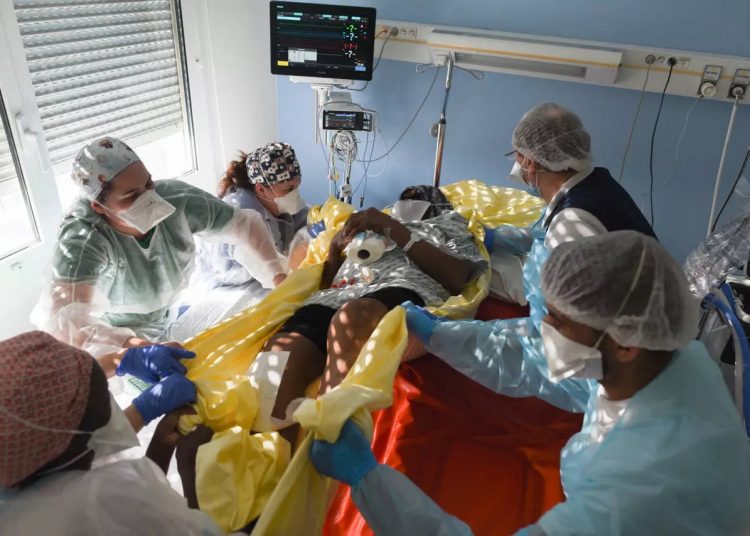Doctors in the Paris region have warned that surging coronavirus infections could soon overwhelm intensive care units, forcing them to make decisions about who to treat. FRANCE 24 reports from an emergency room in the capital’s hard-hit northern suburbs, where staff are confident they will weather the storm.
“Morning folks, got a spare bed for us?” hollers the ambulance driver as he wheels a stretcher into the hospital lobby, without pausing for an answer.
Accustomed to driving to and fro between the Paris region’s overstretched hospitals, Olivier Feutry knows exactly where to find the all-important spare beds.
“Sure, we’ve been hiding one for you,” quips the head of the intensive care unit at the Estrée clinic, a private hospital in the suburb of Stains, north of the French capital.
A few minutes later, Feutry’s patient is lying on a bed with a breathing machine gently pumping oxygen into her ailing lungs, and the ambulance driver is soon on his way to collect another patient.
With more than 1,500 patients currently in ICU units across the Paris region, the third wave of the coronavirus pandemic is proving even more brutal than the first. Nationwide, occupancy rates are nearing 90%, meaning health workers have few options to take their patients elsewhere.
The mounting pressure on hospitals has prompted several doctors to sound the alarm, warning that they may soon have to choose which patients they have the resources to treat.
In a sobering warning published on Sunday, a group of 41 ICU doctors said the failure to order a strict lockdown of the public would soon “compel health workers to decide which patient should live and which should die”.
>> Stade de France ‘supersite’ to ramp up Paris region’s sluggish vaccination drive
The situation is especially dire in the Seine-Saint-Denis area around Stains, the poorest department in mainland France, where the daily infection rate is more than twice the national average.
“The talk of choosing between patients is meant to scare the public,” says Feutry, before driving away in his ambulance. “Of course we’re in the midst of a health crisis. But while some head doctors talk to the press, their understaffed teams are working their butts off.”
At the Estrée clinic, anaesthetist Irène Kriegel is confident that hospitals will weather the storm without having to select which patients to treat. But her fear is that non-Covid patients will pay the price as more and more resources are devoted to battling the pandemic.
“As a result, other patients are not getting the same level of care,” she says. “We may see a surge in serious cancer cases in the coming months because of delayed diagnoses.”
Younger patients
After resisting stricter curbs to curtail the spread of Covid-19, President Emmanuel Macron has been forced to change tack this week, announcing a temporary closure of schools and extending partial lockdown measures to all French regions.
Macron also promised to increase the number of ICU beds across the country from roughly 7,000 today to 10,000 – a daunting challenge, as staff at the Estrée clinic are well aware.
When FRANCE 24 first visited in April 2020, the clinic had rushed to set up a makeshift ICU unit by bringing in health workers and equipment from other facilities. By the time the second wave struck last autumn, patients were receiving improved treatment thanks to upgraded machinery and the experience acquired by staff. The clinic then increased the number of ICU beds from 10 to 15 in time for the third wave.
However, finding the human resources to keep up with the change has proved challenging, says Widad Abdi, an emergency care doctor, noting that the hospital now has “more beds and better equipment, but with fewer staff”.
Unlike last year, when cases were more localised, it is now very difficult to transfer doctors from one region to another, because all parts of the country are affected by the pandemic. The absence of a strict lockdown also means that other hospital wards have to remain open as patients continue to come in.
Another difference is the average age of Covid-19 patients in intensive care, which has dropped to around 60. This in turn influences the kind of treatment doctors opt for, whether intubation or a less invasive form of ventilation.
“Our only criteria is the patient’s chance of survival,” says Abdi. “We know that intubation causes abrasions that can prove fatal to elderly patients. So we won’t intubate an 85-year-old who may not survive the process. On the other hand, we’ll be more aggressive with younger patients who have a strong chance of recovery.”
While the first wave killed swiftly among the frail and elderly, the greater resilience of younger patients means they are more likely to occupy ICU beds at length. According to Abdi, the trend will only increase as the third wave spreads to an ever younger public.
“Chronic fatigue, working late at night or partying a little too much … factors that weaken the immune system make us more prone to developing serious infections,” she says, warning that the young are also at risk.
That’s why many doctors are calling for a strict lockdown to stop the third wave of infections in its tracks, warning of a catastrophic overload of cases.
“The alarmist talk is really about trying to curb the spike in infections,” says Romain Spiteri, the head nurse at the Estrée clinic. “We get the impression that the government will use the option of a strict lockdown in much the same way as doctors resort to intubation – at the very last minute.”






Discussion about this post